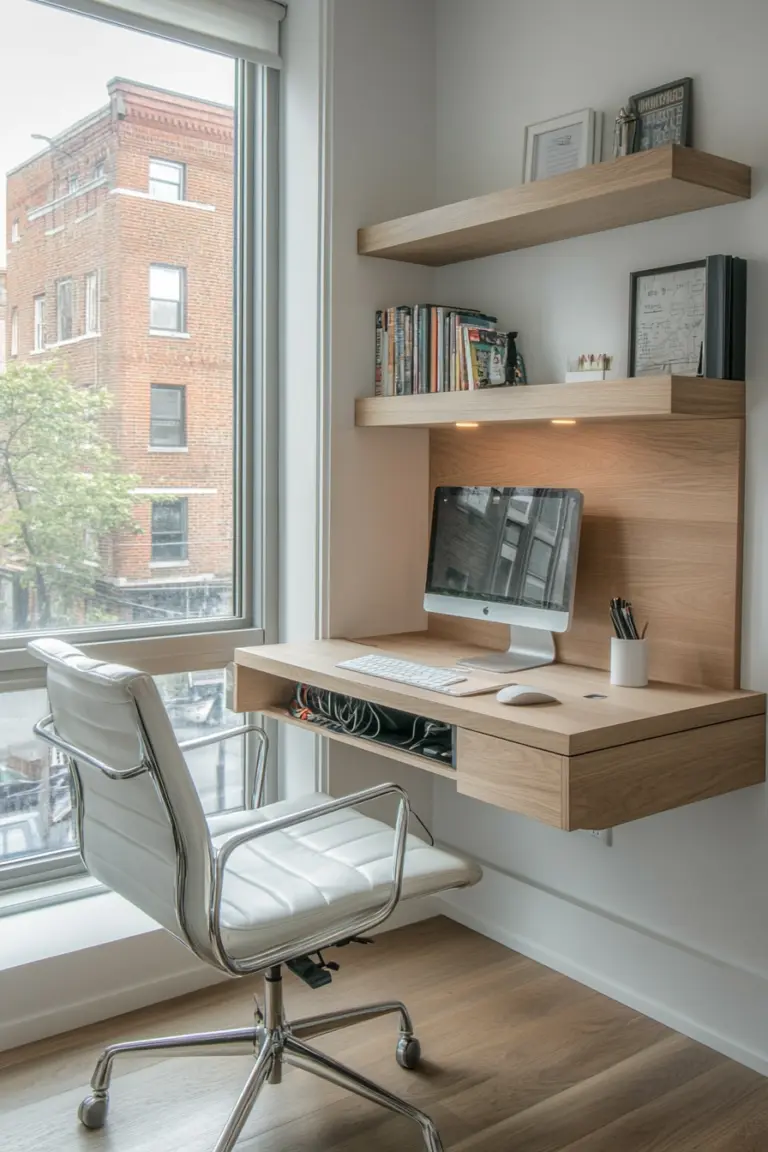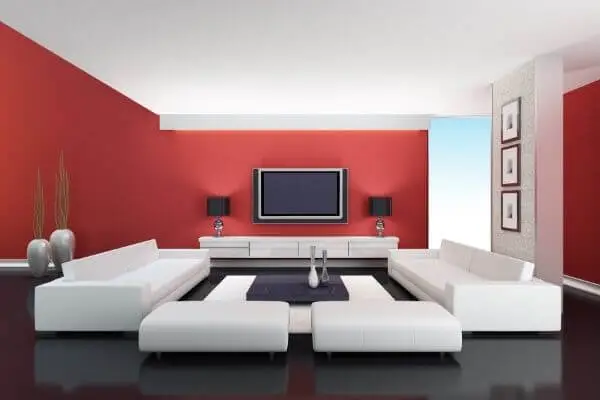Small Dining Room Ideas: 15 Stylish Space-Saving Solutions
Creating a beautiful, functional dining area when space is limited can feel challenging, but with the right approach, even the tiniest dining space can become a stylish focal point in your home. Whether you live in a compact apartment or simply have a small area designated for dining, these innovative ideas will help you maximize every square inch while creating a space that feels both comfortable and inviting.
Understanding Your Small Dining Space Challenges
Before diving into specific solutions, it’s important to assess what makes your dining area challenging. Is it the awkward layout? Limited square footage? Or perhaps the need to make it multipurpose? Understanding your specific constraints will help you choose the most effective solutions.
Small dining spaces typically face these common challenges:
- Limited floor space for furniture placement
- Need for multipurpose functionality
- Difficulty accommodating guests
- Risk of feeling cramped or cluttered
- Balancing style with practicality
The good news is that with smart planning and design choices, these challenges can be transformed into opportunities. Let’s explore comprehensive solutions that address both form and function.
Smart Furniture Placement Strategies
1. Wall-Facing Counter Seating
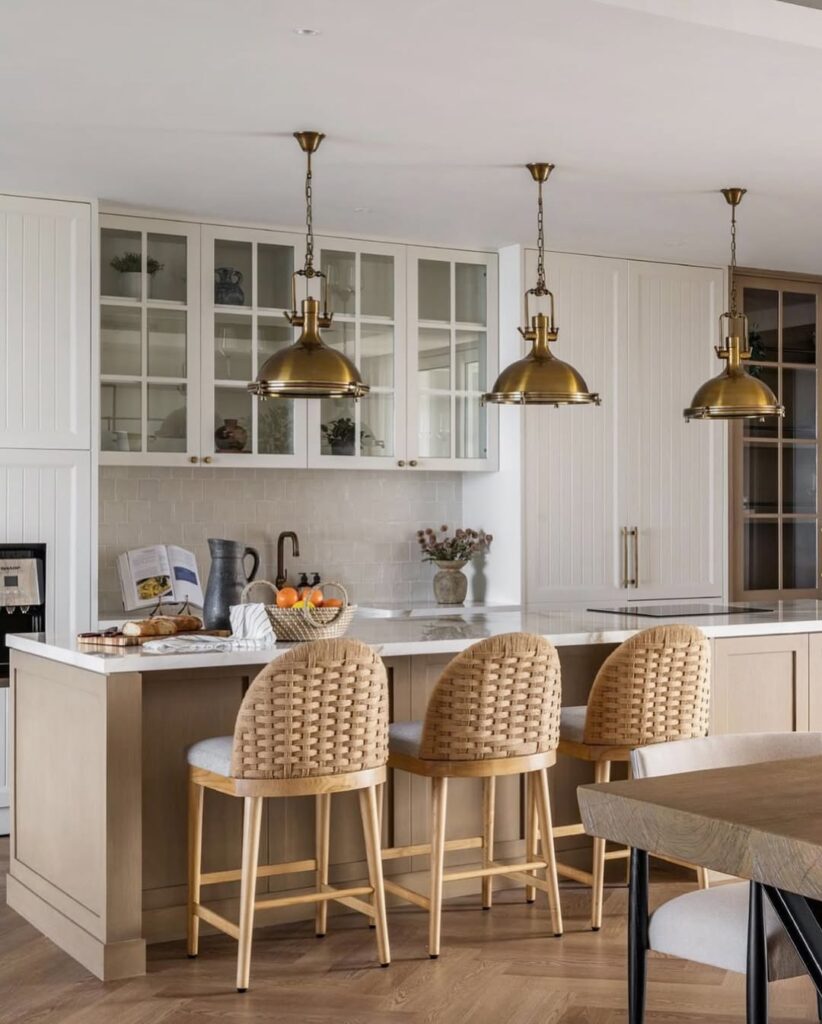
Photo Credit: @Mack Breard
When traditional dining arrangements won’t fit, consider repurposing wall space with counter-style seating. This approach works exceptionally well in narrow spaces where a conventional table would obstruct movement.
Benefits of wall-facing counters:
- Maximizes limited floor space
- Creates a dedicated dining zone without requiring much room
- Can double as a work surface or food prep area
- Stools can be tucked completely away when not in use
For enhanced functionality, consider installing a fold-down wall-mounted table that can be collapsed when not in use. This provides flexibility for homes where dining needs vary day to day.
Related: Small Space Dining Table Ideas: How To Choose And Style
2. Window-Adjacent Dining Solutions
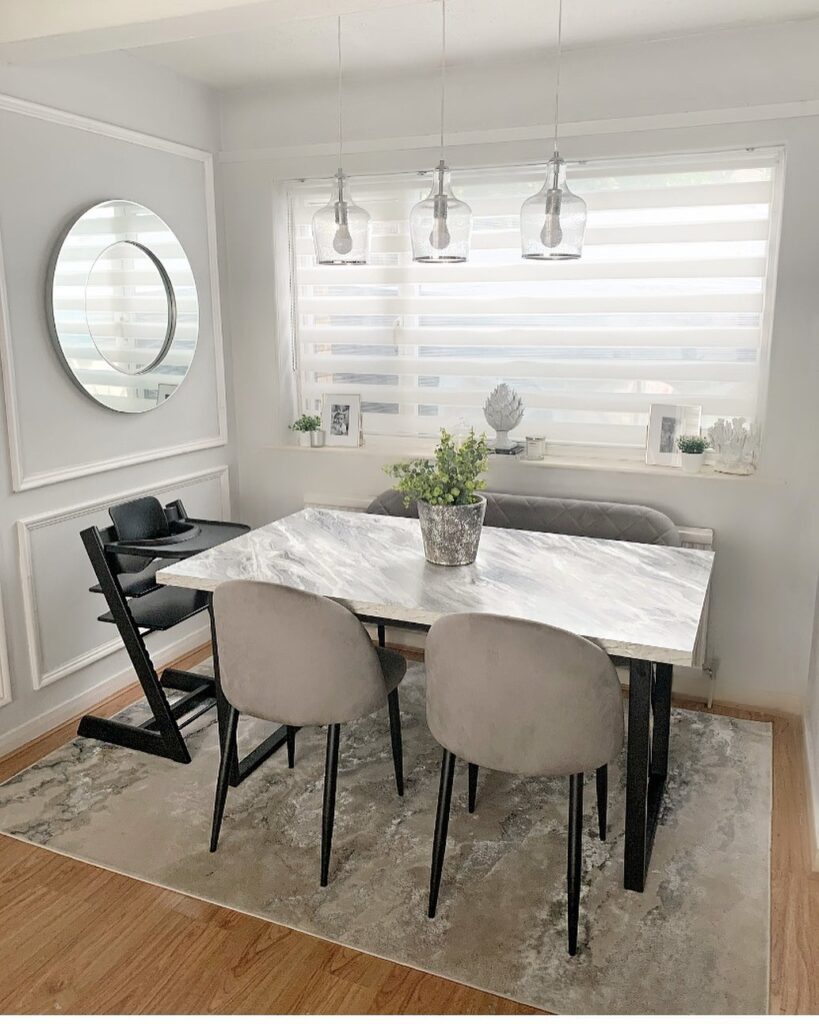
Photo Credit: @our_littlegreyhome
Positioning your dining area near a window offers multiple advantages in a small space:
- Natural light makes the area feel larger and more open
- Views create a sense of expansiveness
- The window sill can sometimes double as a shelf for candles or plants
- Daylight improves the dining experience and mood
A counter or small table positioned under a window creates not just a dining area but a pleasant spot to enjoy morning coffee, work remotely, or help children with homework while enjoying natural light.
3. Corner Optimization Techniques
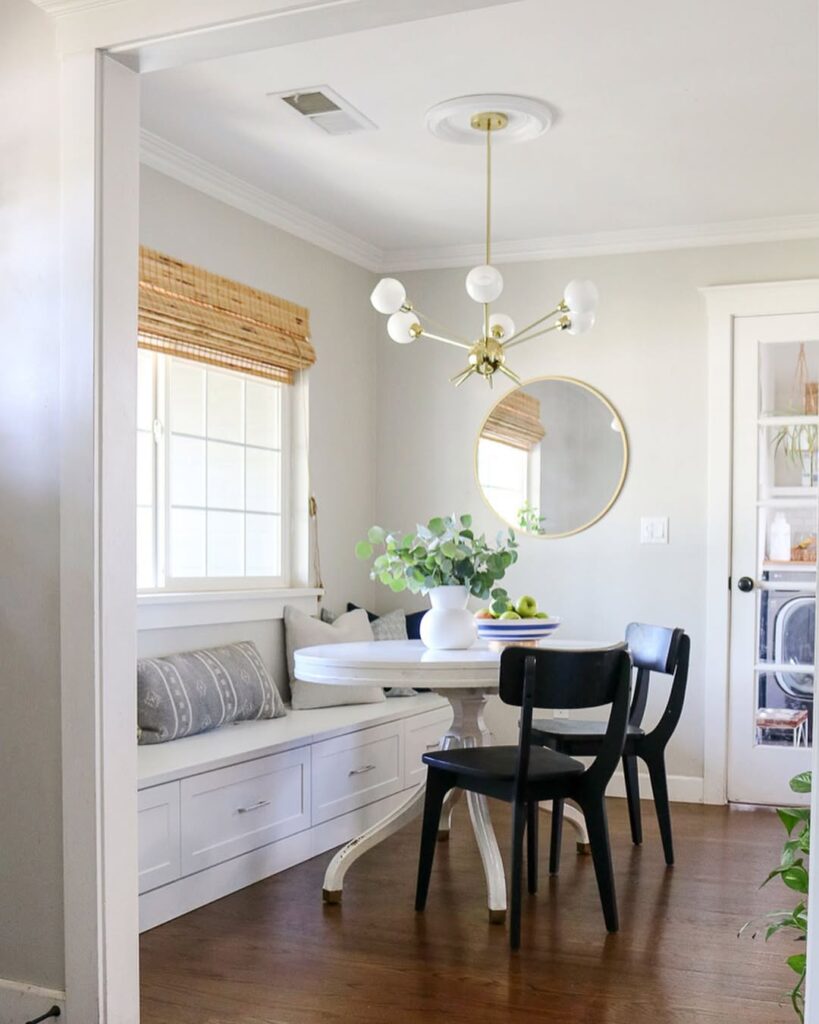
Photo Credit: @thekatrinablair
Corners are often underutilized in small homes, but they can be perfect for dining areas:
- L-shaped bench seating maximizes seating capacity while minimizing footprint
- Corner tables fit naturally into awkward spaces without disrupting traffic flow
- Built-in corner banquettes with storage underneath serve dual purposes
- Corner placement keeps central floor areas open for movement
When designing a corner dining space, consider round or oval tables rather than rectangular ones to soften the angles and improve traffic flow around the dining area.
Space-Enhancing Design Elements
4. Color Schemes for Small Dining Rooms
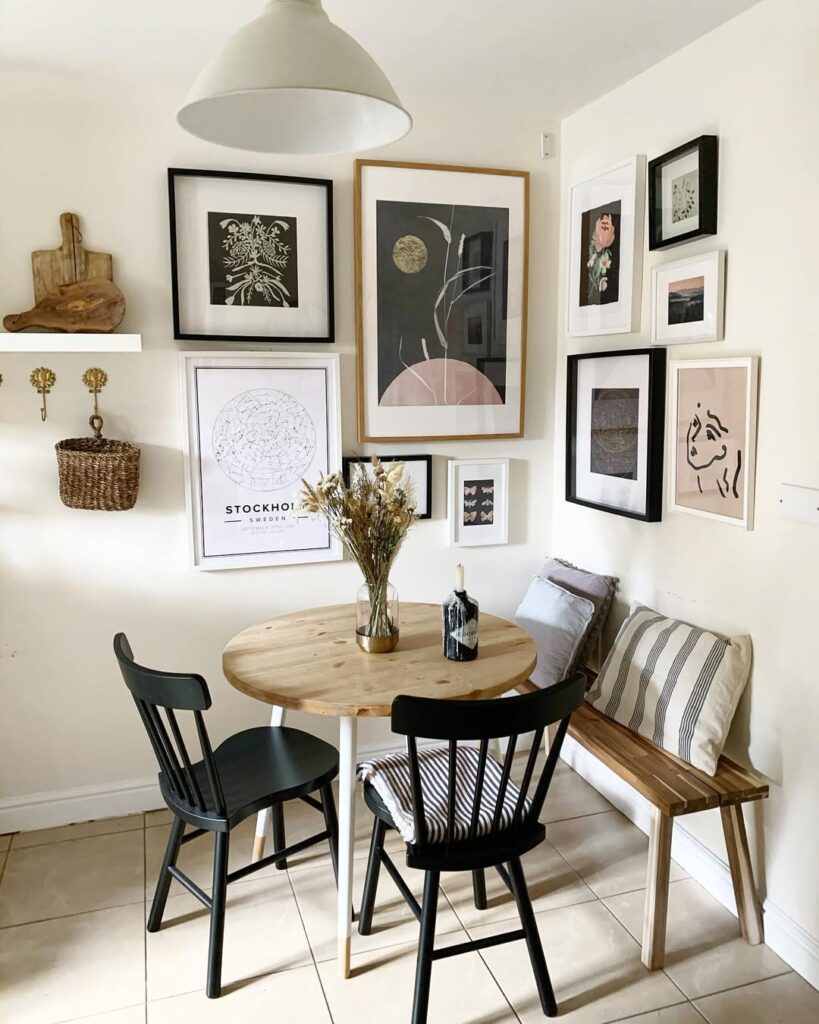
Photo Credit: @melanieamccrindle
The right color palette can dramatically affect how spacious your dining area feels. Strategic color choices can visually expand your small dining room:
- Light neutrals: Whites, creams, soft grays, and pale beiges reflect light and make walls appear to recede
- Monochromatic schemes: Using varying shades of the same color creates depth without visual clutter
- Strategic accents: Incorporating one bold color through accessories or a single accent wall adds interest without overwhelming the space
- Ceiling treatments: Painting the ceiling a lighter shade than the walls creates the illusion of height
Color psychology for dining spaces:
| Color | Psychological Effect | Best Used For |
|---|---|---|
| Soft Blues | Calming, appetite control | Creating serene, sophisticated dining environments |
| Warm Yellows | Cheerful, stimulating | Morning dining areas, breakfast nooks |
| Gentle Greens | Balancing, refreshing | Creating a natural, harmonious atmosphere |
| Soft Terracotta | Warming, cozy | Evening dining spaces, intimate settings |
| Crisp White | Clean, spacious | Maximizing light, modern minimalist aesthetics |
Rather than following trends blindly, choose colors that complement your existing decor while maximizing the perception of space. Consider how your color choices will look under both natural daylight and evening artificial lighting.
5. Small Dining Room Lighting Solutions
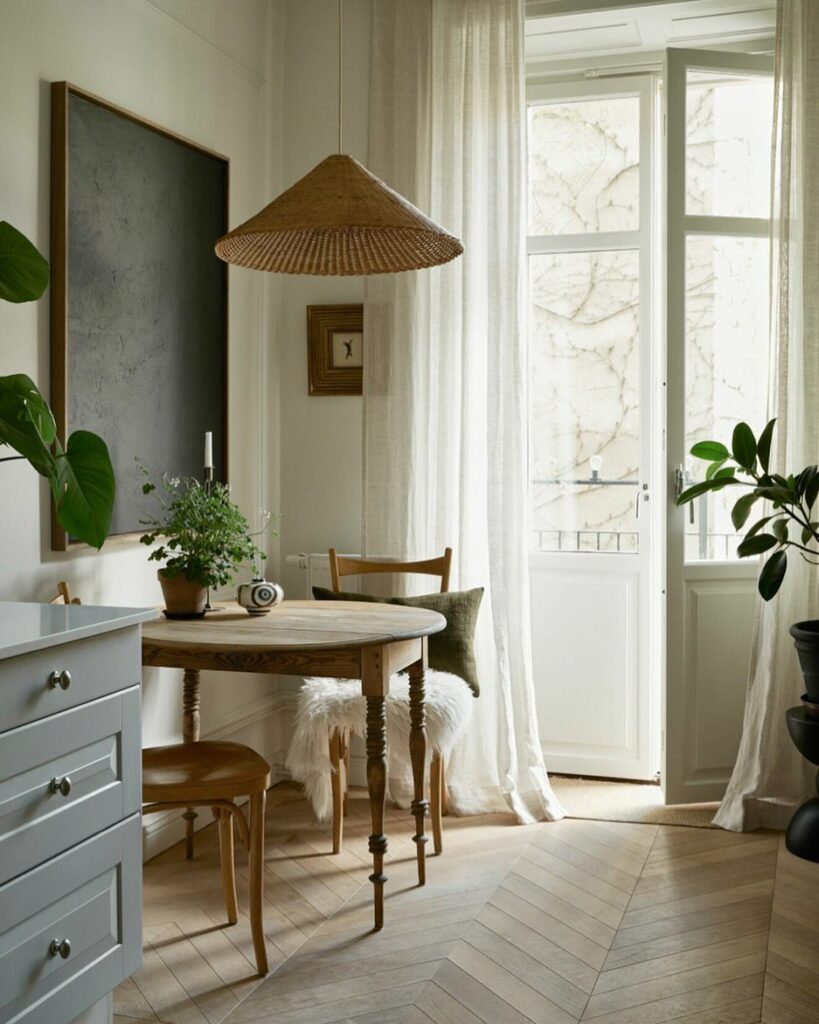
Photo Credit: @myscandinavianhome
Lighting plays a crucial role in small dining spaces—not just for functionality, but for creating atmosphere and the perception of space:
- Statement pendant lights: Draw the eye upward and create a focal point without consuming valuable floor space
- Adjustable lighting: Dimmer switches allow you to modify brightness for different occasions
- Layered lighting approach: Combine ambient, task, and accent lighting for flexibility
- Wall sconces: Add illumination without requiring table or floor space
- Hidden LED strips: Can be installed under shelving or cabinetry to add depth and dimension
When selecting a statement light fixture for a small dining area, ensure the scale is appropriate. An oversized fixture can visually overwhelm the space, while one that’s too small may look insignificant and fail to define the dining zone properly.
6. Mirror Placement Strategies
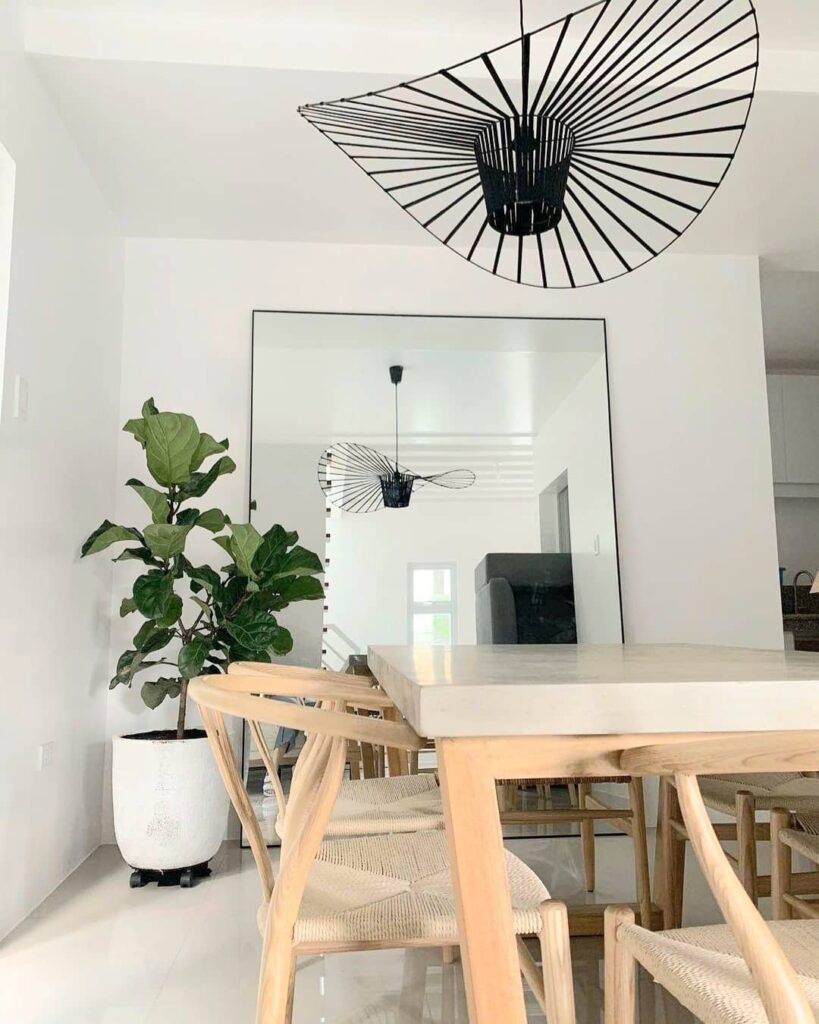
Photo Credit: @espejomnl
Mirrors are powerful tools for visually expanding small dining rooms:
- Position mirrors to reflect windows, doubling the natural light
- Use a large mirror on one wall to create the illusion of doubled space
- Consider mirrored cabinet doors for both storage and spatial enhancement
- Place mirrors strategically to reflect your most attractive decor elements
A carefully positioned mirror opposite a window not only maximizes light but creates a more dynamic visual experience by bringing outdoor views deeper into your space.
Multi-Functional Dining Solutions
7. Kitchen-Integrated Dining Areas
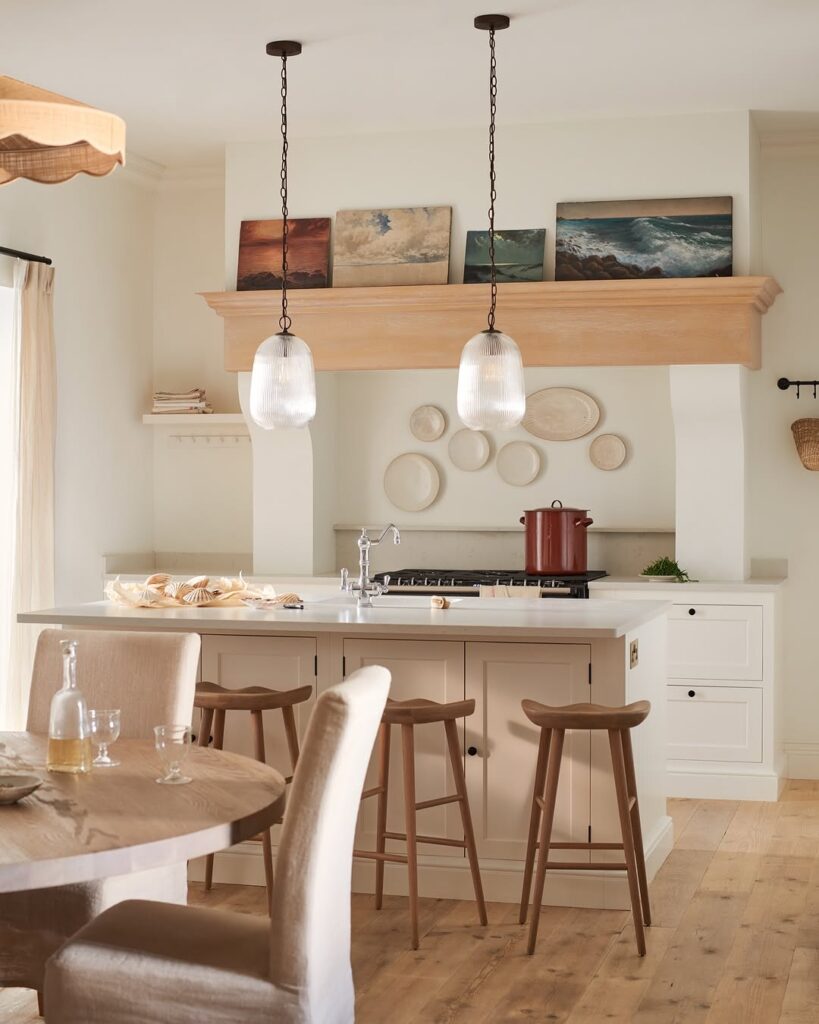
Photo Credit: @hobsons_choice
When space is truly limited, integrating your dining area with your kitchen can be an excellent solution. This approach maximizes available square footage while creating a cohesive, flowing space:
- Extended kitchen islands: Adding an overhang and seating to your kitchen island creates instant dining space
- Kitchen-facing counters: Unlike wall-facing counters, these allow for social interaction while cooking
- Partial dividers: Use half-walls, glass partitions, or changes in flooring to delineate dining space without physical separation
- Convertible surfaces: Chopping blocks or workspace that can be cleared for dining
The advantage of kitchen-integrated dining is the efficiency—food doesn’t need to be transported far, and the cook can remain part of the conversation. This arrangement works particularly well for casual family meals and entertaining while preparing food.
Related: How To Arrange Furniture In Living Room Dining Room Combo
8. Convertible and Expandable Furniture
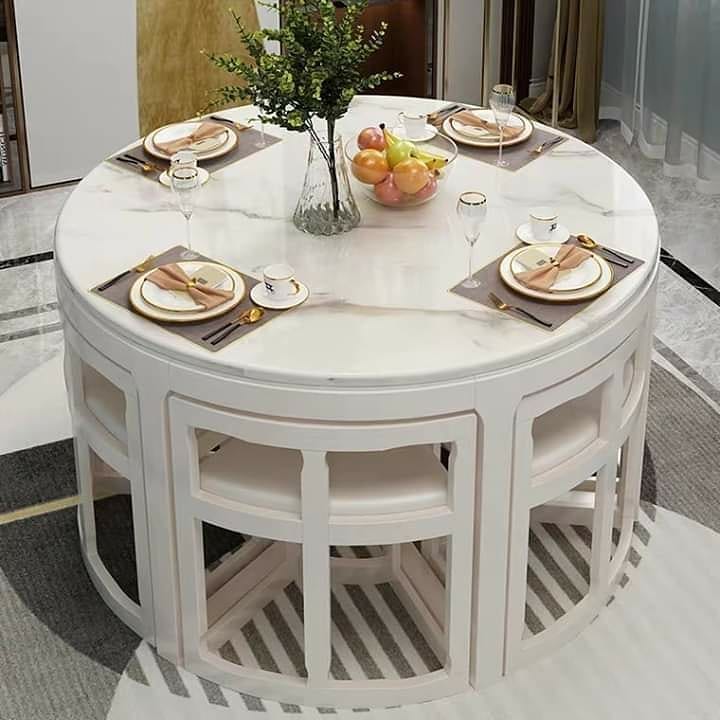
Photo Credit: @DECOR BY SAMRA
Investing in adaptable furniture allows your dining space to transform based on your needs:
- Drop-leaf tables: Can be expanded when guests arrive and collapsed when more floor space is needed
- Extendable dining tables: Feature hidden leaves that pull out to accommodate extra diners
- Nesting tables: Smaller tables that tuck under a main table but can be pulled out for larger gatherings
- Convertible consoles: Appear as slim console tables but expand to full dining tables when needed
Consider this comparison of space-saving table options:
| Table Type | Space Saving Potential | Best For | Considerations |
|---|---|---|---|
| Drop-leaf | High | Very small spaces | Less stable when extended |
| Extendable | Medium | Occasional entertaining | Requires storage for leaves |
| Round with pedestal | Medium | Small square rooms | Better traffic flow |
| Wall-mounted fold-down | Very high | Extremely tight spaces | Requires wall installation |
When selecting expandable furniture, ensure the piece functions well in both its compact and expanded states. The mechanism should be easy to operate, and the table should remain stable when expanded.
9. Dual-Purpose Dining Areas
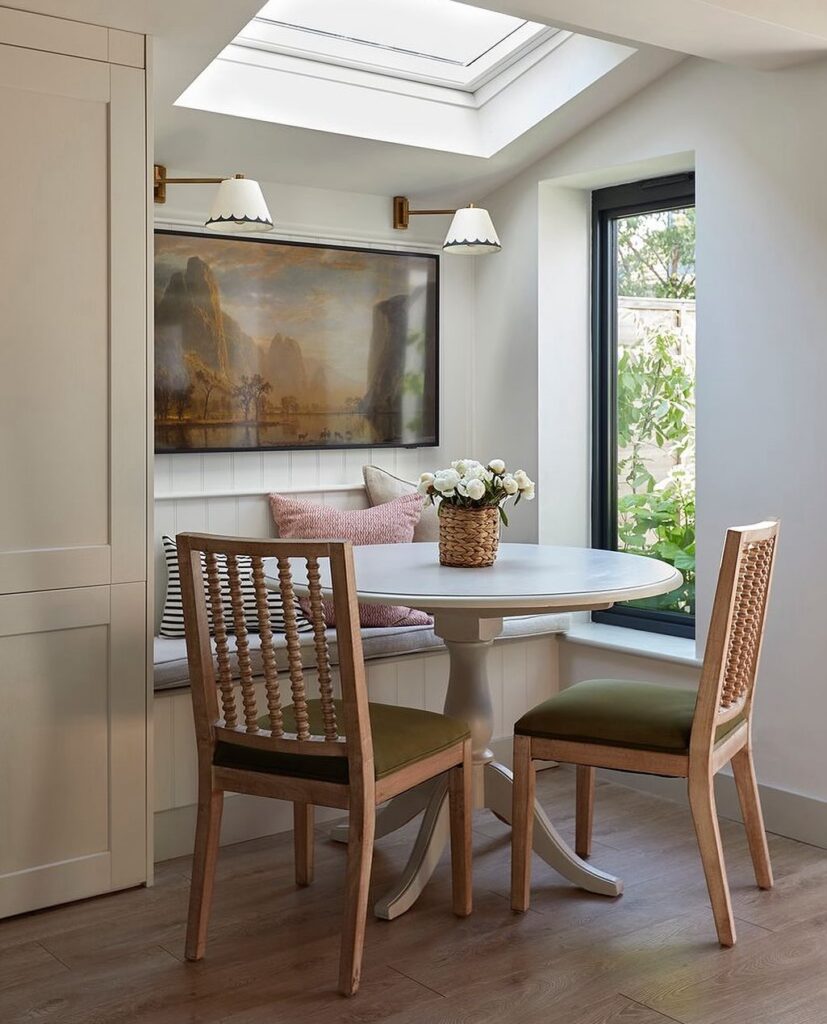
Photo Credit: @pureprojects_
In small homes, spaces often need to serve multiple functions. Your dining area might also need to function as:
- A home office or workspace
- A homework station for children
- A crafting or hobby area
- A game table for family activities
- An entertaining space for guests
To make these dual-purpose spaces work effectively:
- Choose appropriate storage solutions: Closed cabinets or drawers to hide work materials or hobby supplies when dining
- Select appropriate seating: Chairs that are comfortable enough for extended sitting if the table will be used for work
- Consider surface durability: If crafting or children’s activities will take place, ensure the table surface can withstand these uses
- Plan for technology: Incorporate discreet power outlets or cable management if the space will be used for work
A dining area that gracefully transitions between functions throughout the day maximizes the utility of your limited space while maintaining aesthetic appeal.
10. Built-In Dining Solutions
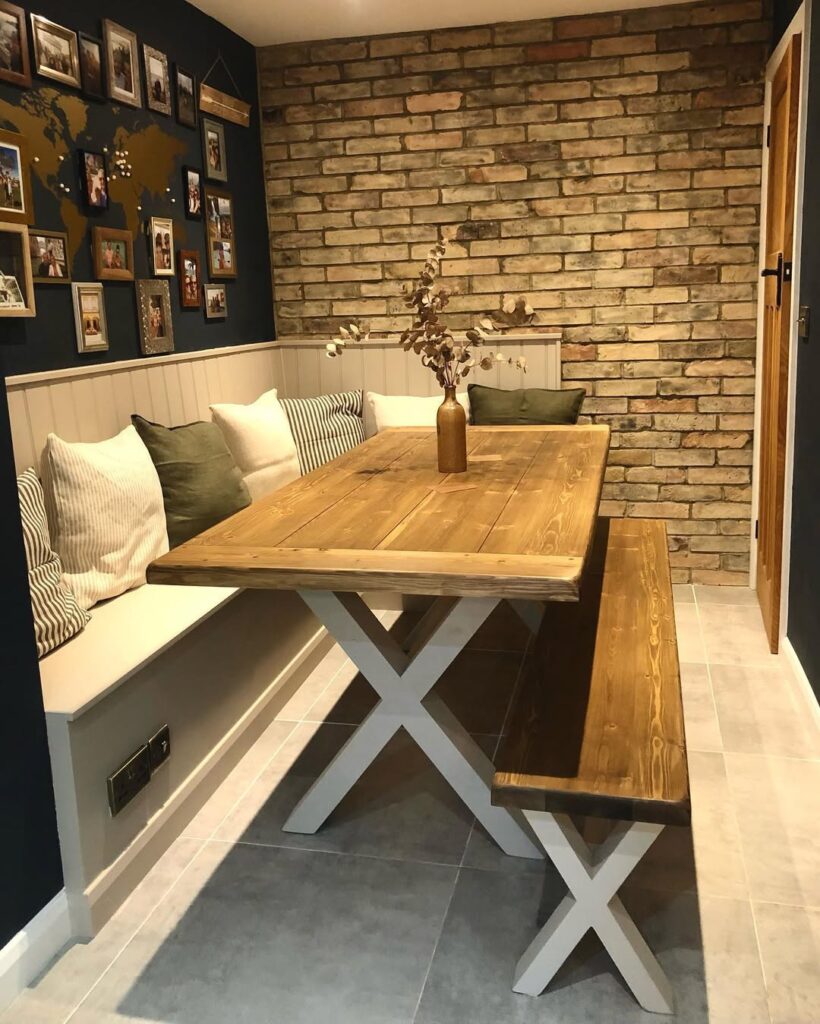
Photo Credit: @_zena__maria
Custom built-ins can be the perfect solution for awkwardly shaped dining areas:
- Built-in banquettes: Maximize seating while following the contours of your space
- Window-seat dining: Combine a window seat with a table for space efficiency
- Wall niches: Take advantage of recessed areas for dining furniture
- Under-stair dining: Utilize this often-wasted space for a cozy dining nook
Decorative Elements That Enhance Small Dining Spaces
11. Small Dining Room Rug Options
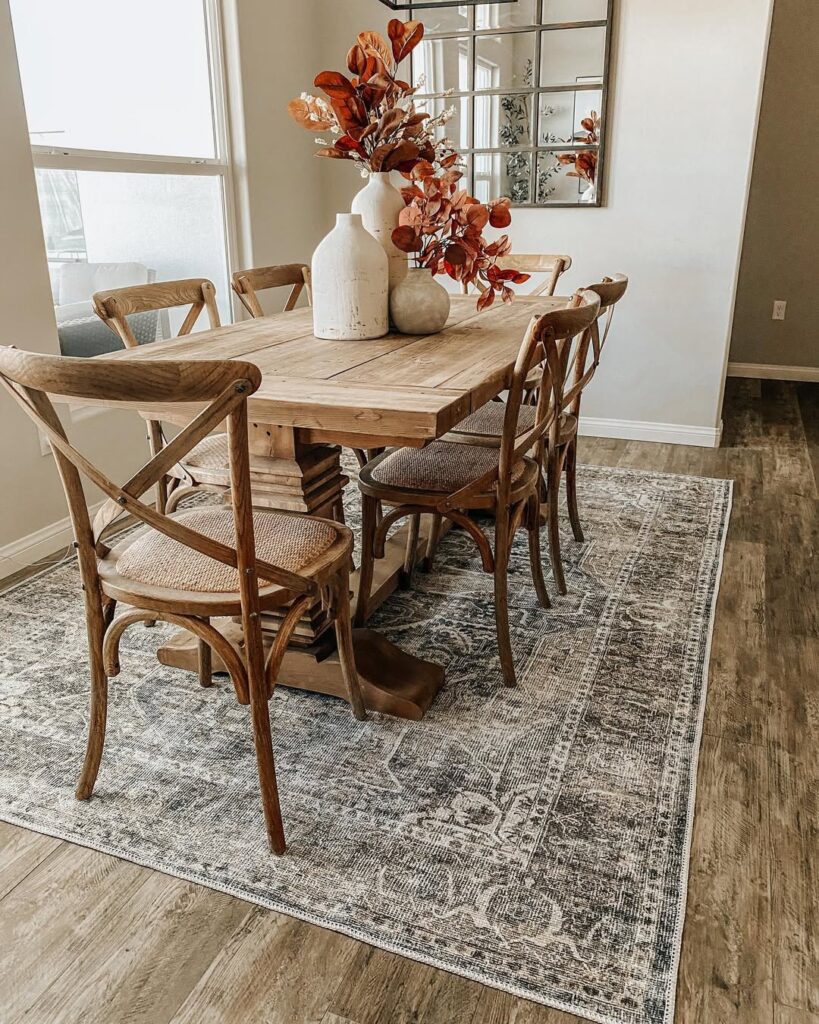
Photo Credit: @austincreekfarmhouse
The right rug can define your dining space, add warmth, and inject personality without consuming any additional floor space. When selecting a dining room rug for small areas:
- Size considerations: Choose a rug large enough to accommodate the table and chairs (even when pulled out), but not so large that it overwhelms the space
- Material selection: Opt for flat-weave or low-pile rugs that won’t interfere with chair movement
- Pattern impact: Use patterns strategically—horizontal stripes can make a room appear wider, while vertical stripes can make it seem longer
- Indoor-outdoor options: Consider durable, stain-resistant materials for easy cleaning in high-traffic dining areas
Best small dining room rug options:
| Rug Type | Benefits | Visual Impact |
|---|---|---|
| Flatweave | Chair-friendly, easy to clean | Adds texture without bulk |
| Round | Works well with round tables | Softens angular rooms |
| Indoor/Outdoor | Extremely durable, stain-resistant | Increasingly stylish options |
For extremely small spaces, consider forgoing a traditional dining rug and instead use decorative floor tiles or a painted floor pattern to define the dining zone without consuming visual space.
12. Small Dining Room Wall Decor

Photo Credit: @umbrellatree.in
Walls present valuable opportunities to enhance your dining space without consuming precious floor area:
- Gallery walls: Create visual interest with a collection of artwork or photographs
- Single statement piece: One large-scale art piece can become a focal point
- Floating shelves: Add storage and display space for decorative items or dining essentials
- Wall-mounted plate displays: Functional items become decorative elements
- Vertical gardens: Living walls add natural elements and improve air quality
When designing wall decor for small dining spaces, consider scale carefully. Too many small pieces can create visual clutter, while appropriately sized elements can add interest without overwhelming the space.
13. Window Treatments for Dining Rooms
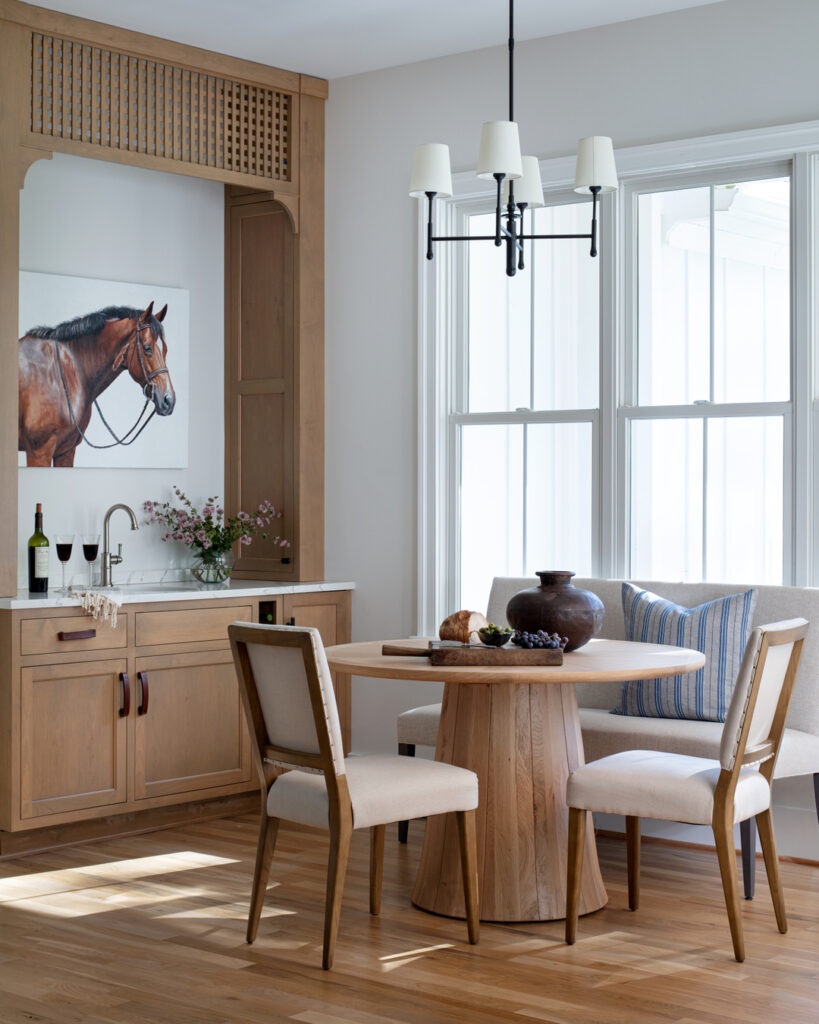
Photo Credit: @jtwdesignllc
The right window treatments balance privacy needs with light control while enhancing your decor:
- Sheer curtains: Filter light while maintaining brightness
- Roman shades: Clean lines that don’t consume visual space
- Café curtains: Cover only the lower portion of windows for privacy while allowing maximum light
- Top-down/bottom-up shades: Adjustable for optimal light and privacy control
- Smart blinds: Programmable to adjust throughout the day based on light conditions
When selecting window treatments for small dining spaces, avoid heavy, dark fabrics that absorb light. Instead, choose lightweight materials that filter light beautifully while maintaining an airy feel.
For dining areas directly adjacent to windows, consider whether the window treatments need to be easily adjustable to control light during meal times. Glare can be disruptive during dining, so having options to filter bright direct sunlight is valuable.
14. Statement Dining Room Lighting
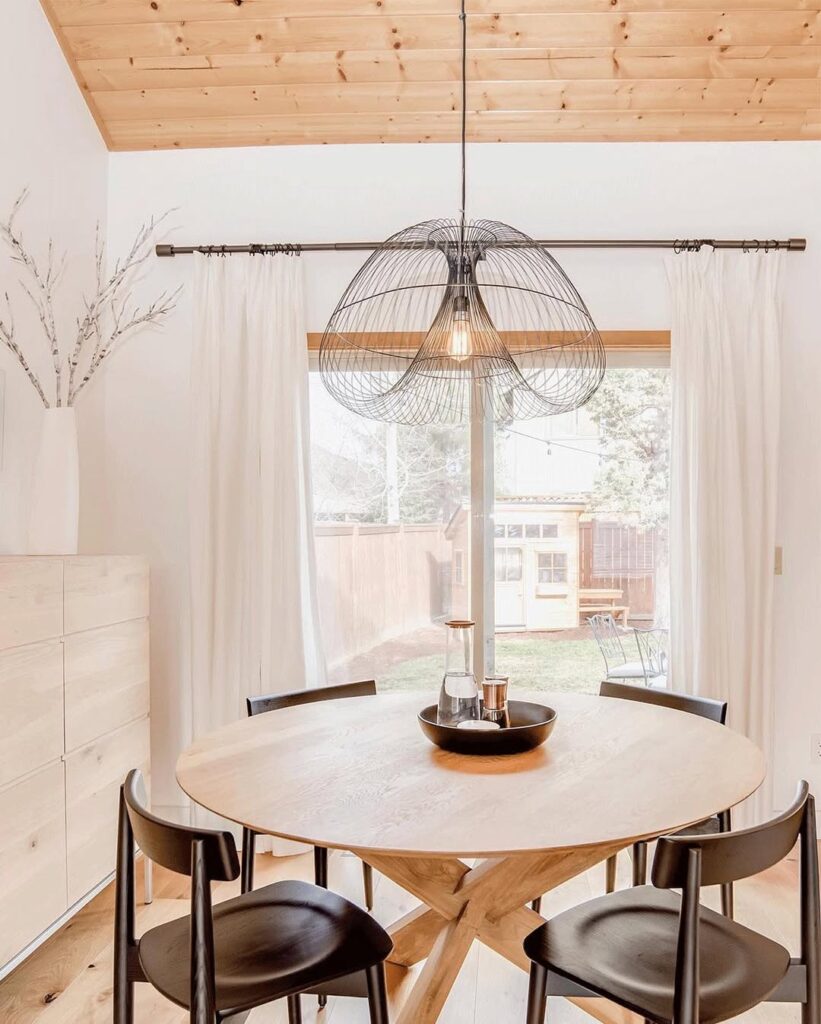
Photo Credit: @crateandbarrel
Beyond basic illumination, lighting fixtures serve as architectural jewelry for your dining space:
- Pendant clusters: Multiple small pendants grouped together create visual interest without the bulk of a single large fixture
- Linear chandeliers: Elongated fixtures that follow the shape of rectangular tables
- Adjustable-height fixtures: Can be raised when not in use to create more headroom
- Unexpected styles: Consider non-traditional options like industrial fixtures or repurposed items for unique character
- Integrated lighting: LED strips under floating shelves or cabinets add ambient light without visible fixtures
The ideal height for dining room pendant lights is typically 30-36 inches above the table surface. For small spaces, this measurement might need adjustment—higher if the fixture is large or if sight lines across the room are important to preserve, slightly lower if creating an intimate dining atmosphere is the goal.
Lighting temperature considerations: Warmer light (2700-3000K) creates a cozy, intimate atmosphere ideal for dining spaces. Avoid cool lighting that can feel clinical and unflattering to both people and food.
Maximizing Small Dining Spaces: Advanced Strategies
15. Small Dining Room Color Schemes
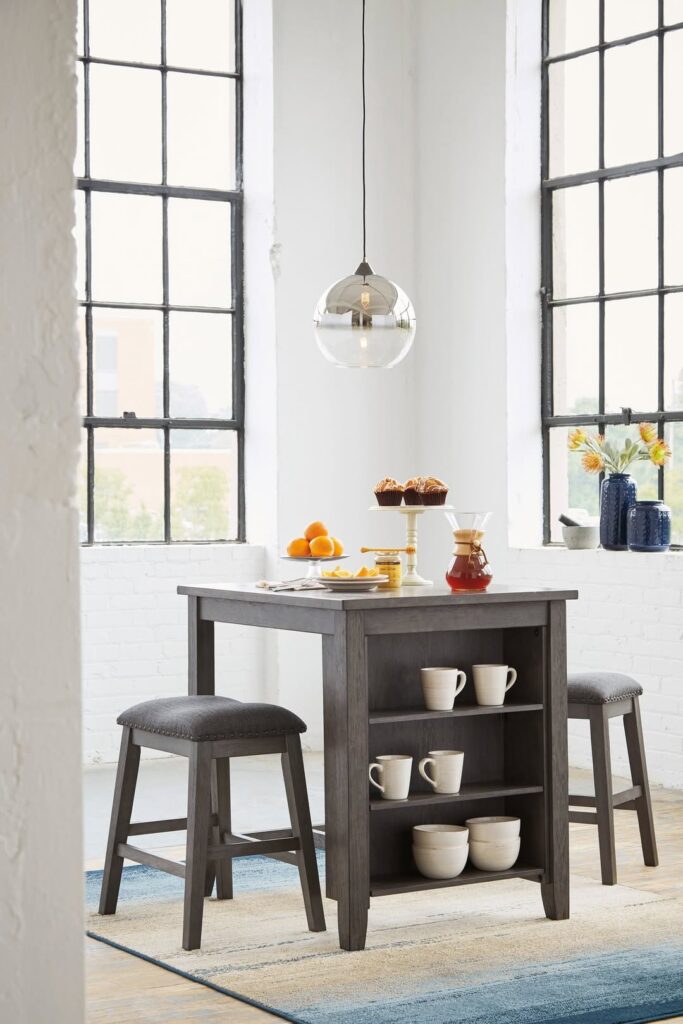
Photo Credit: @ashleyhawaiiofficial
Strategic color application can transform your small dining area:
- Tonal approach: Using different shades of the same color creates depth without visual disconnection
- Color blocking: Designate different functional zones within an open plan using color changes
- Strategic dark colors: When used thoughtfully (like on a ceiling in a room with abundant natural light), darker colors can add drama without closing in the space
- Color continuity: Extending the same color from adjacent spaces creates flow and makes the overall area feel larger
- Two-tone walls: Using a darker color on the bottom half of walls and lighter above can ground the space while keeping it open
Recommended color palette combinations for small dining rooms:
| Primary Color | Accent Color | Effect |
|---|---|---|
| Soft sage green | Warm terracotta | Natural, earthy balance |
| Pale blue-gray | Navy blue | Sophisticated, airy |
| Warm greige | Mustard yellow | Contemporary warmth |
Practical Considerations for Small Dining Spaces
When implementing any of these small dining room ideas, keep these practical considerations in mind:
- Traffic flow: Ensure at least 36 inches of clearance for walkways around the dining area
- Scale appropriateness: Choose furniture proportional to your space—oversized pieces will overwhelm
- Storage integration: Look for dining furniture with built-in storage when possible
- Visual balance: Create equilibrium between design elements to avoid a chaotic feel
- Personal functionality: Prioritize how you actually use the space over how it “should” look
Conclusion
A small dining room doesn’t have to mean compromising on style or functionality. By combining thoughtful furniture placement, strategic design elements, and decorative touches that maximize rather than consume space, you can create a dining area that feels both spacious and inviting.
Remember that small spaces often benefit from a “less is more” approach—choose fewer, higher-quality pieces that serve multiple functions rather than filling the space with numerous smaller items. Focus on what brings you joy in your dining experience, whether that’s conversation, food presentation, or simply having a dedicated place to enjoy meals.
With these 15 comprehensive strategies, you can transform even the tiniest dining area into a space that serves your needs beautifully while reflecting your personal style. The key is to see the limitations of your space not as obstacles but as opportunities for creative problem-solving and innovative design.
What small dining room solutions have worked best in your home? Consider which of these ideas might be most applicable to your specific challenges and start transforming your dining space today.

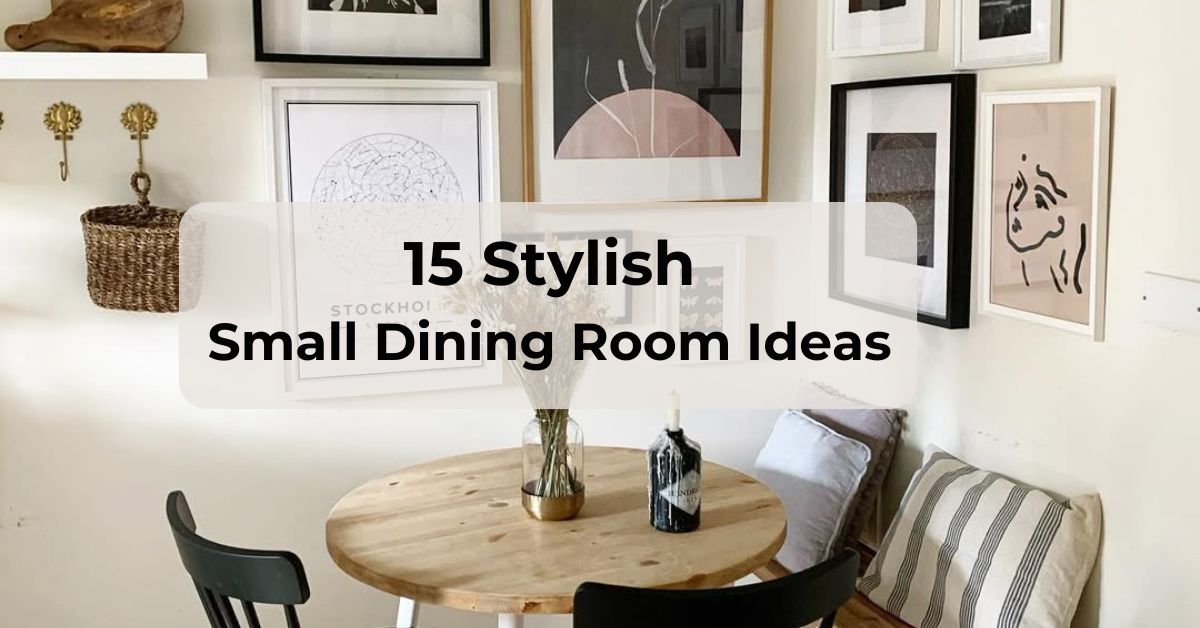
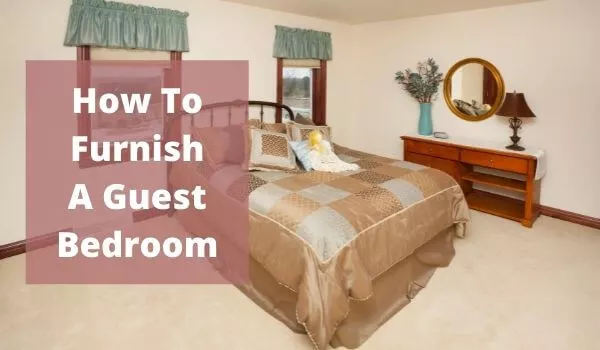
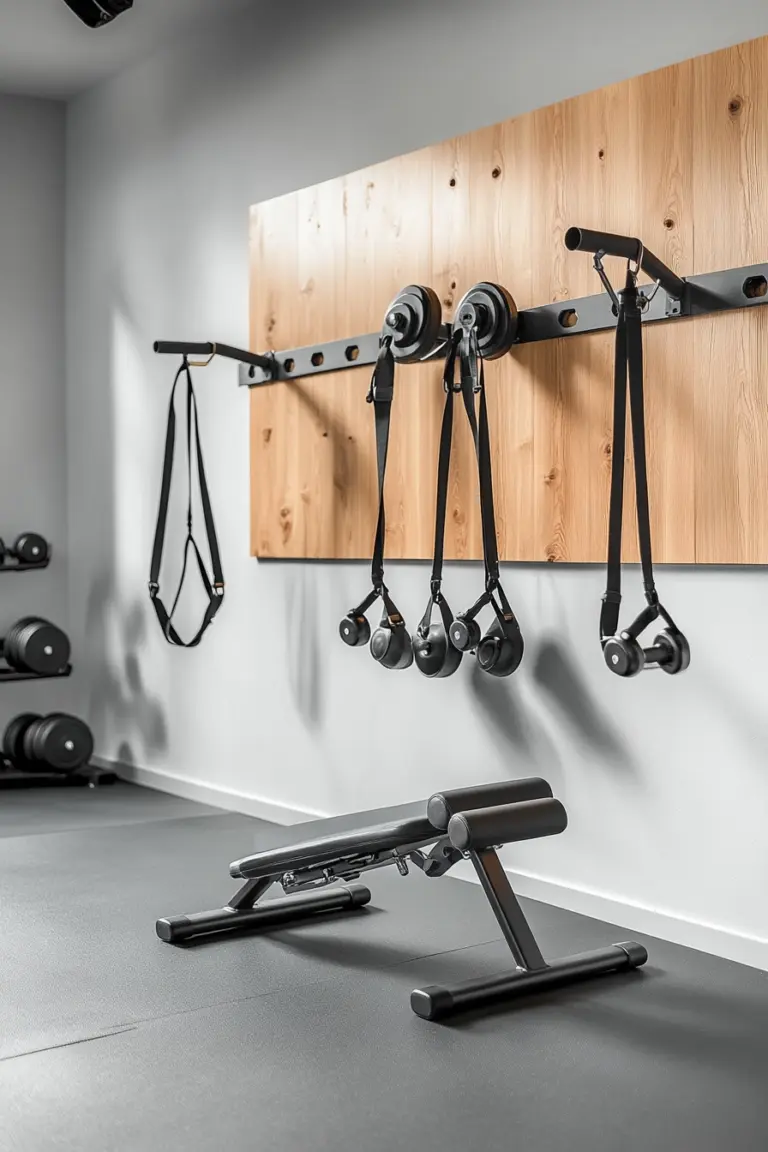
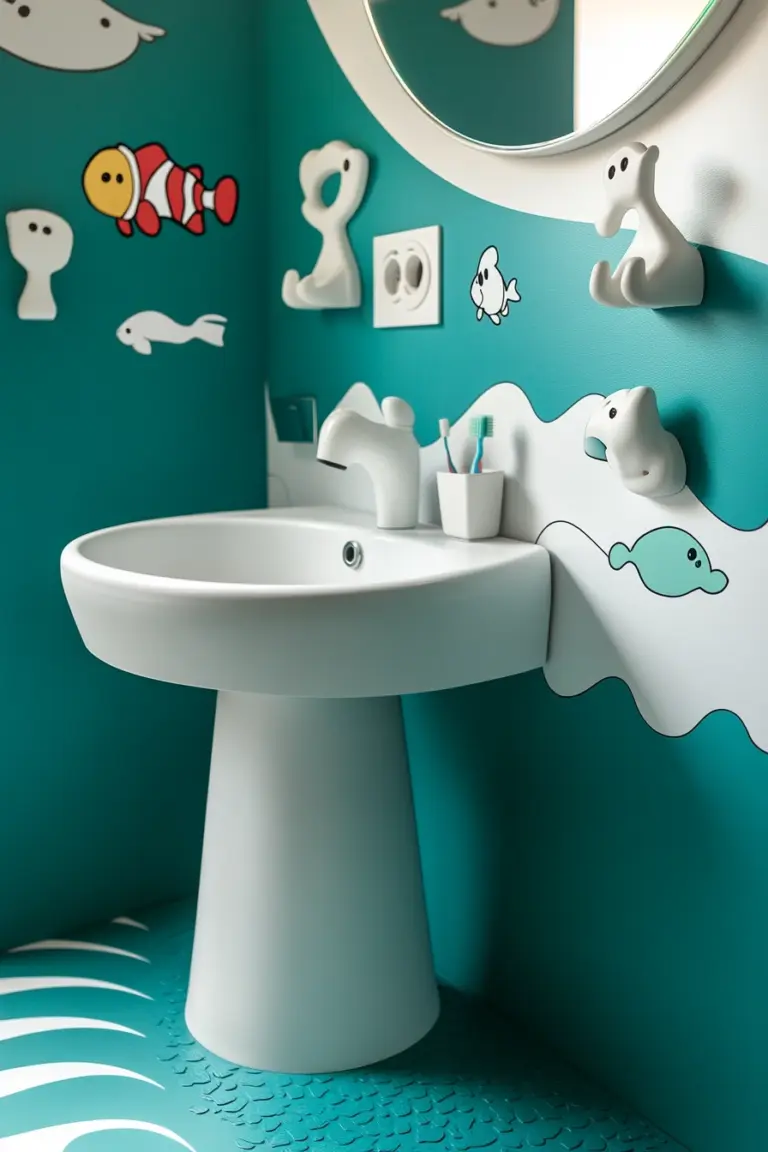
![Men’s Small Bedroom Ideas [10 Must Items] Men’s Small Bedroom Ideas](https://smallspacepros.com/wp-content/uploads/2022/01/Mens-Small-Bedroom-Ideas.webp)
